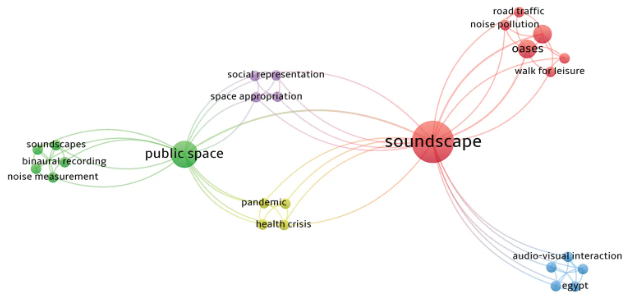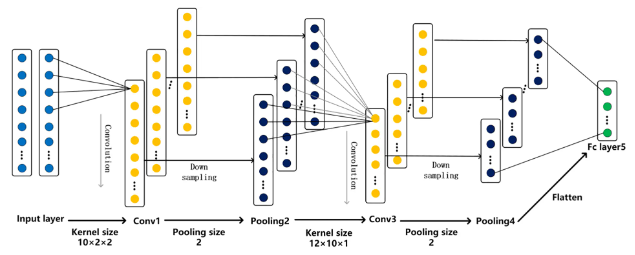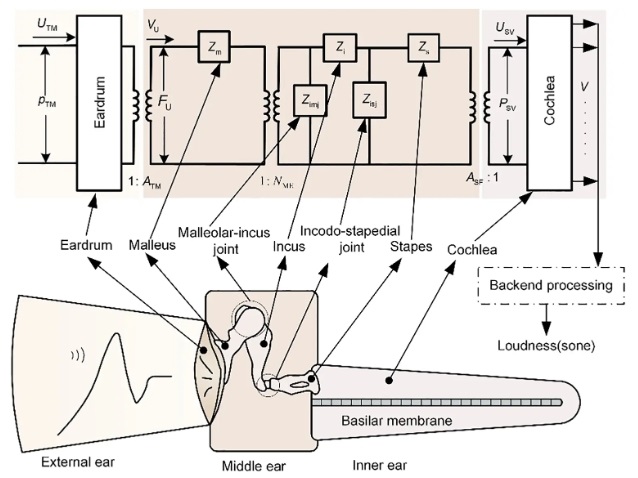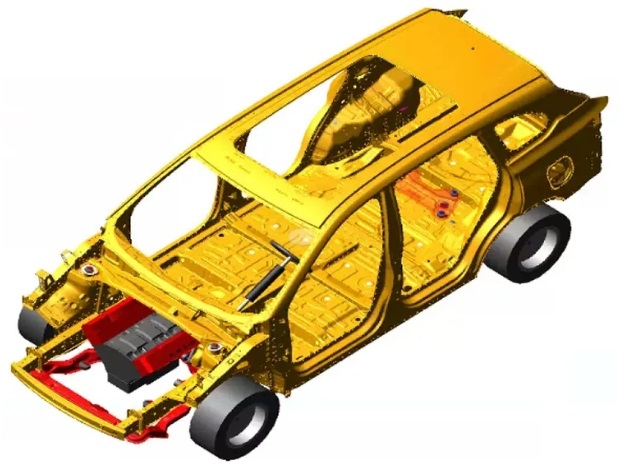Investigation of acoustic properties of rubber diaphragm
Abstract
Large amplitude and high damping play a crucial role in improving sound quality and low-frequency performance of loudspeakers, making it widely applied in electronic devices such as cellphones, tablets, and laptops. However, traditional moving-coil loudspeakers have poor damping performances, and the diaphragm of which is prone to fracture when a large excursion is applied. In this study, a novel ethyl acrylate rubber (AEM) diaphragm was fabricated through solvent casting and thermoforming and assembled to make moving-coil microspeakers (i.e., miniature loudspeakers) with excellent frequency response, amplitude, and damping performances. Meanwhile, the acoustic properties of microspeakers with different diaphragm samples were compared, and the relationships between resonance frequency and elastic modulus in the linear elastic range, the resonance frequency, and mechanical resistance of total-driver losses were revealed and validated by the calculations of mechanical stiffness of driver suspension and mechanical Q-factor of driver. The microspeakers with diaphragm samples “AEM-90-5” fabricated in this study exhibit significant and symmetric excursions; meanwhile, the acoustic properties of microspeakers in the future studies could be optimized by compositions and elastic modulus based on these samples.
References
[1]Thomas S, Visakh PM. Handbook of Engineering and Specialty Thermoplastics: Polyethers and Polyesters. John Wiley & Sons; 2011.
[2]Wang CN, Chang JR, Chang WC. Influences of diaphragm materials on the performance of a microspeaker. Journal of Mechanics. 2015; 31(3): 331–336.
[3]Bae HJ, Lee HJ, Park K. Ultrasonic assisted thermoforming for rapid fabrication of a microspeaker diaphragm. Microsystem Technologies. 2017; 23: 1677–1686.
[4]Huang S, Yang Y, Liu S, Chu X. A large-diaphragm piezoelectric panel loudspeaker and its acoustic frequency response simulation method. Applied Acoustics. 2017; 125: 176–183.
[5]Lin M, Trubianov M, Yang K, et al. Lightweight acoustic hyperbolic paraboloid diaphragms with graphene through self-assembly nanoarchitectonics. Science and Technology of Advanced Materials. 2024; 25(1): 2421757.
[6]Bi H, Wei Y, Zhou Y, et al. Broadband response diaphragm materials for human acoustics engineering. Small. 2025; 21(1): 2406559.
[7]Thiele AN. Loudspeakers in vented box: Part 1. Journal of The Audio Engineering Society. 1961; 22: 181–191.
[8]Thiele AN. Loudspeakers in vented box: Part 2. Journal of The Audio Engineering Society. 1961; 22: 192–204.
[9]Small RH. Vented-box loudspeaker systems part 1: Small-signal analysis. Journal of the Audio Engineering Society. 1973; 21: 363–372.
[10]Small RH. Vented-box loudspeaker systems part 2: Small-signal analysis. Journal of the Audio Engineering Society. 1973; 21: 438–444.
[11]Small RH. Vented-box loudspeaker systems part 3: Small-signal analysis. Journal of the Audio Engineering Society. 1973; 21: 549–554.
[12]Small RH. Vented-box loudspeaker systems part 4: Small-signal analysis. Journal of the Audio Engineering Society. 1973; 21: 635–639.
[13]Hwang, SF, Liu HK, Liao WC, Cheng YK. Fabrication and characterization of diaphragm headphones based on graphene nanocomposites. Materials. 2024; 17(4): 933.
[14]Sun Q, Cui C, Li J, et al. Microstructure, mechanical properties, and adhesion behavior of DLC/W coating on Al-Mg loudspeaker diaphragm for enhancing its acoustic performance. Colloid and Interface Science Communications. 2024; 59: 100778.
[15]Jiang, ZX, Park JH, Xu DP, Hwang SM. Analysis and prediction of mid-high peak frequency for microspeaker with side-firing front chamber. Applied Sciences. 2023; 13(2): 1018.
[16]Park J, Han J. A study on sound radiation characteristics of slim speaker system. IEEE Access. 2023; 11: 63167–63175.
[17]Ma Y, Lu Y, Deng N, et al. A PZT MEMS loudspeaker with a quasi-closed diaphragm. Sensors and Actuators A: Physical. 2023; 358: 114454.
[18]Lee, Y, Choi H, Jang J. Fabrication and characterization of lead lanthanum zirconate titanate ceramic-based fully transparent piezoelectric loudspeakers for next-generation electronic devices. Sensors and Actuators A: Physical. 2025; 382: 116087.
[19]Xu D, Yu Q, Shen F, et al. An analytical model for a pneumatic vibration isolator with the stiffness effect of the elastomeric diaphragm. Shock and Vibration. 2018; 2018(1): 8209290.
[20]Lucas I, del Real RP, Michelena MD, et al. Resonance frequency dependence on out-of-plane forces for square silicon membranes: Applications to a MEMS gradiometer. Sensors and Actuators A. 2010; 163: 75–81.
[21]Kim HJ, Yang WS, No K. Improvement of low-frequency characteristics of piezoelectric speakers based on acoustic diaphragms. IEEE Transactions on Ultrasonics, Ferroelectrics, and Frequency Control. 2012; 59(9): 2027–2035.
[22]Oh SJ. Relationship between the resonance frequency and QTS for microspeaker (Korean). Korean Journal of Materials Research. 2011; 21(7): 403–409.
[23]Oh SJ. Study of the properties of a micro-speaker as functions of the diaphragm thickness (Korean). Sae Mulli (The Korean Physical Society). 2006; 52(6): 536–541.
[24]Oh SJ, Kim HY. Correlation between tensile strength of diaphragm and resonance frequency for micro-speaker (Korean). The Journal of the Acoustical Society of Korea. 2009; 28(4): 299–307.
[25]Yang H, Yao X, Yan H, et al. Anisotropic hyper-viscoelastic behaviors of fabric reinforced rubber composites. Composite Structures. 2018; 187: 116–121.
[26]Dong Y, Yao X, Xu X. Cross section shape optimization design of fabric rubber seal. Composite Structures. 2020; 256: 113047.
[27]Han R, Wu Y, Quan X, Niu K. Effects of crosslinking densities on mechanical properties of nitrile rubber composites in thermal oxidative aging environment. Journal of Applied Polymer Science. 2020; 137(36): e49076.
[28]Han R, Shao Y, Quan X, Niu K. Effects of titanate on the bonding properties of silicone rubber and polyester fabric. Polymer Composites. 2021; 42: 2370–2379.
[29]Sahoo BP, Naskar K, Dubey KA, et al. Study of dielectric relaxation behavior of electron beam-cured conductive carbon black-filled ethylene acrylic elastomer. Journal of Materials Science. 2013; 48: 702–713.
[30]Xin H, Shepherd DET, Dearn KD. Strength of poly-ether-ether-ketone: Effects of sterilisation and thermal ageing. Polymer Testing. 2013; 32: 1001–1005.
[31]Lilaonitkul A, Cooper SL. Properties of polyether-polyester thermoplastic elastomers. Rubber Chemistry and Technology. 1977; 50(1): 1–23.
[32]Medalia AI. Elastic modulus of vulcanizates as related to carbon black structure. Rubber Chemistry and Technology. 1973; 46(4): 877–896.
[33]Schön P, Dutta S, Shirazi M, et al. Quantitative mapping of surface elastic moduli in silica-reinforced rubbers and rubber blends across the length scales by AFM. Journal of Materials Science. 2011; 46: 3507–3516.
[34]Jiang ZX, Park KH, Hwang SM. Design and analysis of watch speaker to enhance waterproof performance by using liquid silicone rubber side diaphragm. Sensors & Actuators A: Physical. 2022; 338: 113452.
[35]Kim KM, Park K. Numerical investigation on vibration characteristics of a micro-speaker diaphragm considering thermoforming effects. Journal of Mechanical Science and Technology. 2013; 27(10): 2923–2928.
[36]Klippel GmbH. Klippel product brochure. Available online: http://www.klippel.de/uploads/media/KLIPPEL_Brochure_RnD_QC_CTR.pdf (accessed on 1 February 2024).
[37]Wu YT, McBride E. Ethylene-acrylic elastomers. In: Kirk RE, Othmer DF (editors). Kirk–Othmer Encyclopedia of Chemical Technology. John Wiley & Sons; 2000. pp. 696–703.
[38]Kumar ES, Das CK, Banik K, Mennig G. Viscoelastic properties of in situ composite based on ethylene acrylic elastomer (AEM) and liquid crystalline polymer (LCP) blend. Composites Science and Technology. 2006; 67: 1202–1209.
[39]Gao T, Na B, Choi H, Chung K. Effect of zinc oxide induced metal-ligand crosslink on the mechanical properties in the ethylene acrylic elastomer (AEM). Materials Letters. 2018; 214: 154–157.
[40]Campos PV, Albuquerque ARL, Angélica RS, Paz SPA. FTIR spectral signatures of amazon inorganic phosphates: Igneous, weathering, and biogenetic origin. Spectrochimica Acta Part A: Molecular and Biomolecular Spectroscopy. 2021; 251: 119476.
[41]Eisa MY, Al Dabbas M, Abdulla FH. Quantitative identification of phosphate using X-Ray diffraction and Fourier transform infrared (FTIR) spectroscopy. International Journal of Current Microbiology and Applied Sciences. 2015; 4(1): 270–283.
[42]Osswald J, Fehr KT. FTIR spectroscopic study on liquid silica solutions and nanoscale particle size determination. Journal of materials science. 2006; 41: 1335–1339.
[43]Ellerbrock R, Stein M, Schaller J. Comparing amorphous silica, short‑range‑ordered silicates and silicic acid species by FTIR. Scientific Reports. 2022; 12: 11708.
[44]Klippel W. Prediction of speaker performance at high amplitudes. Available online: http://www.klippel.de/fileadmin/klippel/Files/Know_How/Literature/Papers/Prediction_of_speaker_performance_at_high_amplitudes_01.pdf (accessed on 1 February 2024).
[45]Klippel W, Schlechter J. Distributed mechanical parameters describing vibration and sound radiation of loudspeaker drive units. Available online: https://www.klippel.de/fileadmin/klippel/Files/Know_How/Literature/Papers/Distributed%20parameter.pdf (accessed on 1 February 2024).
[46]Dong G. Sound quality improvement of dynamic loudspeaker by material selection of diaphragm. In: Proceedings of the 2022 International Conference on Acoustics, Fluid Mechanics and Engineering and the 12th Green’s Function Seminar (AFME&GFS 2022); 25–27 November 2022; Nanjing, China.
[47]Lin JM, Lin CH. A novel flexible planar loudspeaker with coils on polyimide diaphragm. Journal of Vibroengineering. 2017; 20(1): 774–781.
[48]Lee K, Seo J, Kwon SS, et al. Vibroacoustic characteristics of a specific patterned polymer with graphene for an electrostatic speaker. ACS Applied Materials & Interfaces. 2023; 15: 7319–7328.
[49]Heydt R, Kornbluh R, Eckerle J, Pelrine R. Sound radiation properties of dielectric elastomer electroactive polymer loudspeakers. In: Proceedings of the Smart Structures and Materials 2006: Electroactive Polymer Actuators and Devices (EAPAD); 27 February–3 March 2006; San Diego, CA, USA.
[50]Huang J, Feng X, Chen S, Shen Y. Analysis of total harmonic distortion of miniature loudspeakers used in mobile phones considering nonlinear acoustic damping. The Journal of the Acoustical Society of America. 2021; 149(3): 1579–1588.
[51]Chang C, Wang C, Shiah YC, Huang JH. Numerical and experimental analysis of harmonic distortion in a moving-coil loudspeaker. Communications in Nonlinear Science and Numerical Simulation. 2013; 18(7): 1902–1915.
[52]Shmilovitz D. On the definition of total harmonic distortion and its effect on measurement interpretation. IEEE Transactions on Power Delivery. 2005; 20(1): 526–528.
[53]Knapp G. Characterization and optimization of polymer membranes for acoustic applications [PhD thesis]. University of Leoben; 2015.
Copyright (c) 2025 Author(s)

This work is licensed under a Creative Commons Attribution 4.0 International License.









